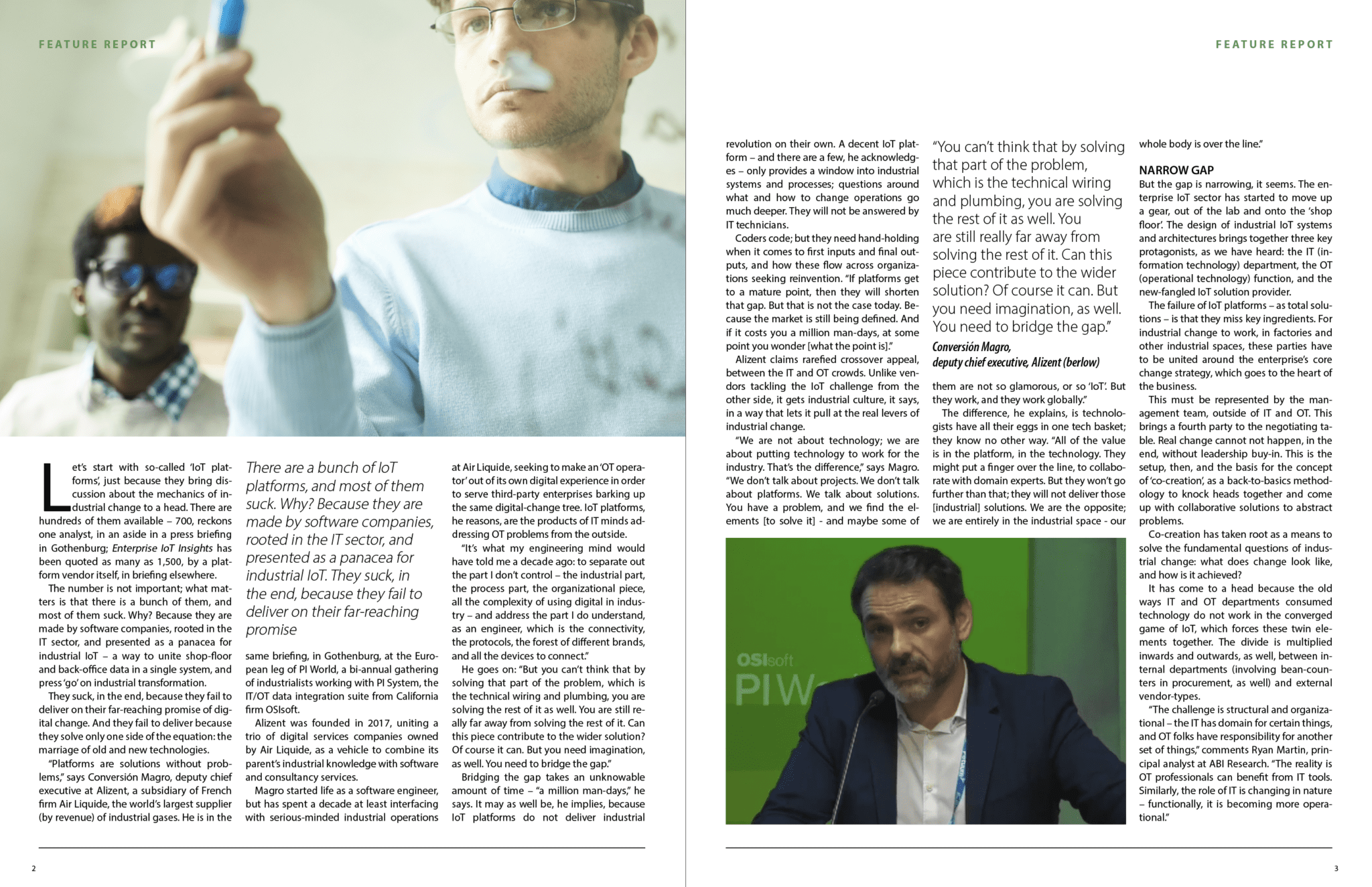This is an excerpt from a full report called ‘Crossing the IT/OT divide – from co-creation to co-configuration, and how to bring industrial IoT to scale’. The report, part of Enterprise IoT Insights’ ongoing Digital Factory Solutions series, is available to download (for free) from here. Other entries in the Digital Factory Solutions series can be found here.
Let’s start with IoT platforms, just because they bring discussion about the mechanics of industrial change to a head. There are hundreds of them available – 700, reckons one analyst, in an aside in a press briefing in Gothenburg; Enterprise IoT Insights has been quoted as many as 1,500, by a platform vendor itself, in briefing elsewhere.
The number is not important; what matters is that there is a bunch of them, and most of them suck. Why? Because they are made by software companies, rooted in the IT sector, and presented as a panacea for industrial IoT – a way to unite shop-floor and back-office data in a single system, and press ‘go’ on industrial transformation.
They suck, in the end, because they fail to deliver on their far-reaching promise of digital change. And they fail to deliver because they solve only one side of the equation: the marriage of old and new technologies.
“Platforms are solutions without problems,” says Conversión Magro, deputy chief executive at Alizent, a subsidiary of French firm Air Liquide, the world’s largest supplier (by revenue) of industrial gases. He is in the same briefing, in Gothenburg, at the European leg of PI World, a bi-annual gathering of industrialists working with PI System, the IT/OT data integration suite from California firm OSIsoft.
 Alizent was founded in 2017, uniting a trio of digital services companies owned by Air Liquide, as a vehicle to combine its parent’s industrial knowledge with software and consultancy services.
Alizent was founded in 2017, uniting a trio of digital services companies owned by Air Liquide, as a vehicle to combine its parent’s industrial knowledge with software and consultancy services.
Magro started life as a software engineer, but has spent a decade at least interfacing with serious-minded industrial operations at Air Liquide, seeking to make an ‘OT operator’ out of its own digital experience in order to serve third-party enterprises barking up the same digital-change tree. IoT platforms, he reasons, are the products of IT minds addressing OT problems from the outside.
“It’s what my engineering mind would have told me a decade ago: to separate out the part I don’t control – the industrial part, the process part, the organizational piece, all the complexity of using digital in industry – and address the part I do understand, as an engineer, which is the connectivity, the protocols, the forest of different brands, and all the devices to connect.”
He goes on: “But you can’t think that by solving that part of the problem, which is the technical wiring and plumbing, you are solving the rest of it as well. You are still really far away from solving the rest of it. Can this piece contribute to the wider solution? Of course it can. But you need imagination, as well. You need to bridge the gap.”
Bridging the gap takes an unknowable amount of time – “a million man-days,” he says. It may as well be, he implies, because IoT platforms do not deliver industrial revolution on their own. A decent IoT platform – and there are a few, he acknowledges – only provides a window into industrial systems and processes; questions around what and how to change operations go much deeper. They will not be answered by IT technicians.
Coders code; but they need hand-holding when it comes to first inputs and final outputs, and how these flow across organizations seeking reinvention. “If platforms get to a mature point, then they will shorten that gap. But that is not the case today. Because the market is still being defined. And if it costs you a million man-days, at some point you wonder [what the point is].”
Alizent claims rarefied crossover appeal, between the IT and OT crowds. Unlike vendors tackling the IoT challenge from the other side, it gets industrial culture, it says, in a way that lets it pull at the real levers of industrial change.
“We are not about technology; we are about putting technology to work for the industry. That’s the difference,” says Magro. “We don’t talk about projects. We don’t talk about platforms. We talk about solutions. You have a problem, and we find the elements [to solve it] – and maybe some of them are not so glamorous, or so ‘IoT’. But they work, and they work globally.”
The difference, he explains, is technologists have all their eggs in one tech basket; they know no other way. “All of the value is in the platform, in the technology. They might put a finger over the line, to collaborate with domain experts. But they won’t go further than that; they will not deliver those [industrial] solutions. We are the opposite; we are entirely in the industrial space – our whole body is over the line.”
NARROW GAP
But the gap is narrowing, it seems. The enterprise IoT sector has started to move up a gear, out of the lab and onto the ‘shop floor’. The design of industrial IoT systems and architectures brings together three key protagonists, as we have heard: the IT (information technology) department, the OT (operational technology) function, and the new-fangled IoT solution provider.
The failure of IoT platforms – as total solutions – is that they miss key ingredients. For industrial change to work, in factories and other industrial spaces, these parties have to be united around the enterprise’s core change strategy, which goes to the heart of the business.
This must be represented by the management team, outside of IT and OT. This brings a fourth party to the negotiating table. Real change cannot not happen, in the end, without leadership buy-in. This is the setup, then, and the basis for the concept of ‘co-creation’, as a back-to-basics methodology to knock heads together and come up with collaborative solutions to abstract problems.
Co-creation has taken root as a means to solve the fundamental questions of industrial change: what does change look like, and how is it achieved?
It has come to a head because the old ways IT and OT departments consumed technology do not work in the converged game of IoT, which forces these twin elements together. The divide is multiplied inwards and outwards, as well, between internal departments (involving bean-counters in procurement, as well) and external vendor-types.
“The challenge is structural and organizational – the IT has domain for certain things, and OT folks have responsibility for another set of things,” comments Ryan Martin, principal analyst at ABI Research. “The reality is OT professionals can benefit from IT tools. Similarly, the role of IT is changing in nature – functionally, it is becoming more operational.”
Internally, IT departments have been accustomed to buying technology solutions in piecemeal fashion, choosing from off-the-shelf parts, and mastering their assembly in-house, to their own ends. Christian Renaud at 451 Research puts it well: “It is really refrigerator-door cooking – what can I make out of the ingredients I have?”
It is the same accusation Magro levels at IoT platform vendors, outside the enterprise.
 By contrast, OT departments within organisations seek to buy solutions (‘outcomes’), instead of technologies, the argument goes. They want a fix for preventative maintenance, typically, or a way to automate the production line. But industrial IoT combines these philosophies in service of much grander schemes, which promise to change business processes, enhance customer value, and redefine service offerings. These ends require more thorough beginnings.
By contrast, OT departments within organisations seek to buy solutions (‘outcomes’), instead of technologies, the argument goes. They want a fix for preventative maintenance, typically, or a way to automate the production line. But industrial IoT combines these philosophies in service of much grander schemes, which promise to change business processes, enhance customer value, and redefine service offerings. These ends require more thorough beginnings.
“There is definitely a problem – and the problem is there are at least three sides involved in the transaction,” says Lorenzo Veronesi, research manager at IDC. The IT set, he says, is concerned with functionality and integration, the OT set wants usability and functionality, with a keen eye on risk to security and operations, and the procurement department is hung up on cost, unless a demonstrable two-year return is evident.
He has horror stories about wrong-headed purchasing decisions where IT or procurement teams have held sway, with the result that “less digital” (or less expensive) solutions have been selected over “fully-digital” (more fully featured) ones, to the consternation of workers expected to use them. “They had a solution that didn’t scratch the surface, and was completely overlooked.”
At the same time, Veronesi notes, IT managers are required to manage a new type of ‘shadow’ IT, delivered in app-form by machines builders and procured through OT channels, and must ward off technical duplication and sweet-shop purchases.
“Digital technologies are like fire: a good servant, but a bad master,” he says. Each department has a function in the procurement and design of industrial IoT, he says, and a balance should be struck – to drive scalability, value, and application, respectively.
But let’s pause, and play the blame game, even if momentarily. Is there a sense these two factions are entrenched and guarding their territories? Is it one side’s fault?
This article continues here. The full report, part of Enterprise IoT Insights’ ongoing Digital Factory Solutions series, is available to download for free from here. Other entries in the Digital Factory Solutions series can be found here.

